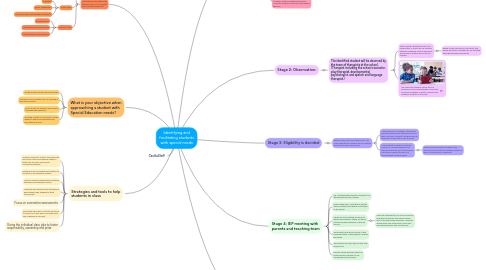
1. Stage 1: Identification in class
1.1. Behaviors patterns to identify students with potential special needs
1.1.1. Anxiety or physical reactions linked to unlying anxiety (stomach ache due to stress)
1.1.2. Students are regularly absent
1.1.3. Isolation from peers and unwillingness to participate.
1.1.4. Feels overwhelmed with daily tasks and classroom expectations
1.1.5. Can’t or don’t complete assignments on a regular basis
1.1.6. Can’t control behavior or reactions
1.1.7. Struggles to express themselves
1.2. Class teacher would keep progress report on students who are struggling in class. Students might be flagged during the Semester Progress meeting or throughout the year.
2. Stage 2: Observation:
2.1. The identified student will be observed by the team of therapists at the school. (Therapist including the school counselor, play therapist, developmental psychologist, and speech and language therapist.)
2.1.1. After making a detailed report from observation, a choice will be made to determine whether Special Education would have a positive effect on the student.
2.1.1.1. Based on the outcome of the report, the school decides to schedule an IEP meeting with the teachers and parents.
2.1.2. The classroom teacher should start to implement some differentiated instruction and work strategies to better facilitate the student's progress in the class.
3. Stage 3: Eligibility is decided
3.1. Based on the outcome of the report, the school decides to schedule an IEP meeting with the teachers and parents.
3.1.1. If the student is not eligible, the teacher should facilitate them within the limits of their resources. Student's progress will be monitored till the end of the semester.
3.1.2. If the student is eligible for special education, the teaching team can starting writing an IPE (Individualized Education Program) as well as a Individualized Home Program.
3.1.2.1. These resources should be ready to be presented to parents and teachers within 30 days of the decition of eligibility.
4. Stage 4: IEP meeting with parents and teaching team
4.1. IPE: Individualized Education Program IHP: Individualized Home Program
4.2. When scheduling a meeting all parties must be present and aware of the topic of discussion
4.3. The goal of the meeting would be to explain the student's needs, as well as introducing the possibility of the IEP and IHP.
4.3.1. After the meeting the IEP and IHP must be reviewed for the last time before being sent to all responsible members. Members should have clear instructions, structure and responsibilities they must follow.
4.4. The parents must give consent to the implementation of the student's special education.
4.5. The parents' would be able to give their opinion and
4.6. Parents should have the option to bring outside evaluation to be considered in the process
5. Stage 5: The implementation of the IEP
5.1. Communication between the parents and teachers should happen every week
5.2. The student should be reevaluated after 6 months to determine if the IEP is still relevant or if it should be modified.
5.3. The IEP should be understood and accepted by the classroom environment to further a inclusion classroom culture.
6. What should skills should the teacher focus on? ( This may differ between students)
6.1. Conceptual Skills
6.1.1. Language and speech
6.1.2. Math
6.1.3. Reasoning and critical thinking
6.1.4. Memory
6.2. Social Skills
6.2.1. Empathy
6.2.2. Social Judgement
6.2.3. Communication with teachers and peers
6.3. Practical Skills
6.3.1. Independence
6.3.2. Ownership and Responsibility
6.3.3. Understanding consequences
